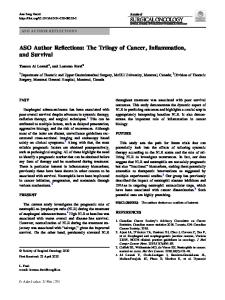ASO Author Reflections: Lung Adenocarcinoma with Accidental Invisible Pleural Dissemination Lesions: Wait-and-See Strate
- PDF / 193,036 Bytes
- 2 Pages / 595.276 x 790.866 pts Page_size
- 77 Downloads / 340 Views
ASO AUTHOR REFLECTIONS
ASO Author Reflections: Lung Adenocarcinoma with Accidental Invisible Pleural Dissemination Lesions: Wait-and-See Strategy for Tumors with Indolent Biologic Characteristics Wen-Fang Tang, MD1,2 and Wen-Zhao Zhong, PhD1 1
Guangdong Lung Cancer Institute, Guangdong Provincial Key Laboratory of Translational Medicine in Lung Cancer, Guangdong Provincial People’s Hospital and Guangdong Academy of Medical Sciences, Guangzhou, China; 2Shantou University Medical College, Shantou, China
PAST Recently, a series of studies have reported the survival benefit of primary tumor resection for non-small cell lung cancer patients with localized pleural seeding found unexpectedly during surgery (stage 4, s-pM1a).1 However, for initial treatments after surgery, it remains controversial whether significant differences in survival exist between chemotherapy, targeted therapy, and the wait-and-see strategy. Similarly, it is challenging to select subsequent treatments for patients who have relapsed and experienced pleural dissemination lesions after surgery (stage 4, r-pM1a). In their previous study, the authors proposed that s-pM1a and r-pM1a represent the same disease, with common indolent biologic behaviors, but in different phases.2 Thus, the authors believed that the wait-and-see strategy might be feasible as an initial treatment for these two special subsets, similar to some special cases of soft tissue sarcoma3 and lymphoma.4 Furthermore, the vast differences between attenuated and rapid progression for pM1a patients with the same disease phase raised the question whether these distinct progression patterns were determined by the genetic characteristics of the tumor, which are reported to correlate with tumor progression.5 Therefore, the current study6 focused on the survival outcomes for patients with s-pM1a or r-pM1a disease treated with the wait-and-see strategy or conventional
Ó Society of Surgical Oncology 2020 First Received: 2 March 2020 W.-Z. Zhong, PhD e-mail: [email protected]
postoperative therapies and evaluated the feasibility of the wait-and-see strategy. In addition, this study explored potential molecular markers associated with progression. PRESENT This study6 retrospectively identified 64 lung adenocarcinoma patients with r-pM1a disease and 67 lung adenocarcinoma patients with s-pM1a disease between January 2009 and June 2016. The survival differences were compared among patients treated with three different initial postoperative treatments: chemotherapy, targeted therapy, and the wait-and-see strategy. The study results showed that the wait-and-see group had favorable progression-free survival (PFS) among the various cohorts. Longer overall survival (OS) was observed for the patients who received chemotherapy or targeted therapy after the wait-and-see strategy than for those who received chemotherapy or targeted therapy immediately. Multivariable analyses showed that lymph node status and treatment group were independent prognostic factors for PFS and OS. The study used whole
Data Loading...











